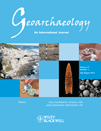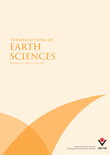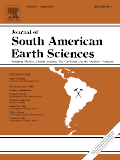
Environmental Earth Sciences
Scope & Guideline
Innovating solutions for contemporary environmental challenges.
Introduction
Aims and Scopes
- Hydrogeochemistry and Water Quality Assessment:
Research focusing on the chemical composition of groundwater and surface water, evaluating the impacts of pollutants, and assessing the suitability of water for various uses, especially in agricultural and urban settings. - Geotechnical Engineering and Soil Mechanics:
Studies on the mechanical properties of soils, including stability analysis of slopes, soil erosion, and the effects of mining activities on soil properties and groundwater. - Landslide and Slope Stability Analysis:
Investigations into the factors contributing to landslides, including hydrological and geological conditions, with applications in risk assessment and management. - Geophysical and Geochemical Investigations:
Utilization of geophysical methods and geochemical analyses to characterize subsurface conditions, assess contamination, and understand groundwater dynamics. - Environmental Impact Assessments:
Research aimed at evaluating the environmental consequences of human activities, including mining, urbanization, and agriculture, with a focus on sustainable management practices. - Climate Change and Hydrology:
Studies examining the impacts of climate change on hydrological cycles, groundwater resources, and ecosystem health, often involving predictive modeling. - Remote Sensing and GIS Applications:
The use of remote sensing technologies and Geographic Information Systems (GIS) for environmental monitoring, land use planning, and resource management. - Geological and Tectonic Studies:
Research focusing on the geological factors influencing environmental processes, including tectonic activity, sedimentation patterns, and natural hazards.
Trending and Emerging
- Machine Learning and AI in Environmental Studies:
The incorporation of machine learning and artificial intelligence techniques for predicting environmental phenomena, assessing risks, and optimizing resource management is rapidly gaining popularity. - Integrated Water Resources Management:
Research focusing on holistic approaches to managing water resources, incorporating climate data, land use changes, and socio-economic factors to develop sustainable practices. - Climate Change Adaptation and Mitigation Strategies:
A growing emphasis on studies that explore adaptation strategies to combat climate change impacts on ecosystems, water resources, and urban planning. - Microbial and Biotechnological Applications:
Exploration of microbial processes and biotechnological solutions for environmental remediation, particularly in contaminated land and water systems. - Geoenvironmental Management and Sustainable Practices:
Increasing attention to sustainable land-use practices, ecological restoration, and the management of natural resources in the context of environmental degradation. - Hydrogeological Modeling and Groundwater Management:
Emerging importance of advanced hydrogeological modeling techniques to evaluate groundwater resources and manage their sustainability under changing environmental conditions.
Declining or Waning
- Traditional Geology Studies:
Research focused solely on geological formations and mineralogy without integration into broader environmental contexts appears to be waning, as interdisciplinary approaches gain more traction. - Conventional Soil Erosion Studies:
While soil erosion remains a critical issue, studies that do not incorporate advanced modeling techniques or the impacts of climate change are becoming less common. - Static Risk Assessment Models:
Static models that do not account for dynamic environmental changes or incorporate real-time data are being overshadowed by more adaptive and responsive modeling techniques. - Single-Factor Environmental Impact Studies:
Research that evaluates environmental impacts based on a single factor (e.g., only chemical pollution) without considering the interactions between multiple environmental stressors is declining.
Similar Journals

Geofizika
Illuminating the Path of Earth Science ResearchGeofizika, an esteemed journal published by the Andrija Mohorovičić Geophysical Institute at the University of Zagreb, presents a significant platform for research in the fields of geophysics and Earth sciences. With an Open Access model established since 1984, this journal ensures that scientific knowledge is accessible to a broad audience, encouraging collaborations and the free exchange of ideas. Geofizika has steadily evolved through its converging years from 1989 to 1999 and has been active from 2003 to the present, reflecting its commitment to advancing geophysical research. The journal has been recognized for its contributions to Earth and Planetary Sciences and has acquired respectable ranks in various categories; notably, it holds a Q4 status in Geophysics as of 2023. Researchers, professionals, and students will find Geofizika a valuable resource for the latest discoveries and methodologies in geophysics, supporting the academic community in expanding the frontiers of knowledge in these vital scientific domains.

Journal of Earth System Science
Empowering Researchers with Open Access InsightsThe Journal of Earth System Science, published by Indian Academy of Sciences, is a pivotal resource in the field of Earth and Planetary Sciences, boasting an impressive Q2 ranking in 2023. Since its inception in 2005, this journal has been dedicated to advancing our understanding of complex Earth systems, publishing high-quality research that spans across various disciplines within the geosciences. With an E-ISSN of 0973-774X and a commitment to Open Access, it makes cutting-edge scientific insights widely available to researchers and professionals alike. The journal serves as a vital platform for innovative research and critical discussions, making significant contributions to the global scientific community, particularly as we navigate the challenges posed by climate change and environmental sustainability. Located in Bangalore, India, it continues to foster international collaboration and discourse among scholars, reinforcing its role as an essential publication within the Earth and Planetary Sciences domain.

Physio-Geo
Innovating Solutions for Ecological ChallengesPhysio-Geo (ISSN: 1958-573X) is a distinguished open-access journal published by REVUES ORG, dedicated to advancing the fields of Earth and Planetary Sciences, with a special focus on Earth-Surface Processes, Environmental Science, and Ecology. Since its inception in 2007, Physio-Geo has provided a platform for researchers, professionals, and students to disseminate and access high-quality studies that contribute to the understanding of our environment. With a convergence period from 2019 to 2024, the journal aims to bridge disciplinary gaps and foster interdisciplinary research that addresses pressing ecological and environmental challenges. Despite its current Scopus rankings reflecting an early-stage development, the journal is poised to enhance its impact within the scientific community, particularly as it embraces a wider audience through its open-access model. By offering valuable insights and comprehensive analyses, Physio-Geo is an essential resource for those seeking to explore the complex interactions between physical geography and ecological systems.

GEOARCHAEOLOGY-AN INTERNATIONAL JOURNAL
Innovating Archaeological Understanding Through GeoscienceGEOARCHAEOLOGY-AN INTERNATIONAL JOURNAL is a leading peer-reviewed publication dedicated to the interdisciplinary study of the interactions between geology and archaeology. Published by Wiley in the United States, this esteemed journal serves as a vital platform for researchers and professionals in the fields of archaeology, earth sciences, and environmental studies. With an impressive impact factor and categorized in the Q1 quartile of subjects such as Archaeology and Earth and Planetary Sciences, it ranks among the top journals in its discipline, reflecting its significant contribution to academic discourse and research innovations. Since its inception in 1986 and projected to continue into 2024, GEOARCHAEOLOGY emphasizes the importance of integrating geological methods within archaeological research, fostering a deeper understanding of human history in relation to the earth’s processes. This journal is an indispensable resource for scholars and students alike who seek to explore the dynamic connections between past human behavior and the geological record.

TURKISH JOURNAL OF EARTH SCIENCES
Fostering Excellence in Earth and Planetary InvestigationsTURKISH JOURNAL OF EARTH SCIENCES, published by the Tubitak Scientific & Technological Research Council Turkey, is a premier platform dedicated to advancing the field of Earth and Planetary Sciences. With an ISSN of 1300-0985, this journal has been a significant contributor to the international scientific community since its inception in 2002, and is set to continue publishing groundbreaking research through 2024. As a recognized journal in the Q2 quartile of Earth and Planetary Sciences, it ranks #98 out of 195 in its category according to Scopus metrics, positioning it within the 50th percentile of its field. The journal emphasizes peer-reviewed research, providing invaluable insights that facilitate scholarly discourse and promote rigorous investigation into various aspects of the Earth sciences. Although it does not currently offer open access, the journal remains a vital resource for academics, professionals, and students seeking to deepen their understanding of geological phenomena and contribute to the advancement of this essential discipline.

Earth and Space Science
Navigating the Nexus of Earth Sciences and Environmental Insights.Earth and Space Science, published by the American Geophysical Union, is a distinguished open-access journal that has profoundly impacted the realms of earth and planetary sciences as well as environmental science since its inception in 2014. With impressive rankings, including Q1 in both Earth and Planetary Sciences and Environmental Science for 2023, this journal ranks 38th out of 195 in the general Earth and planetary sciences category and 51st out of 219 in environmental science, showcasing its commitment to high-quality research dissemination. The journal serves as a vital platform for researchers, professionals, and students, fostering the exploration of critical topics and advancements within these pivotal fields. With an accessible format, researchers can benefit from the rich content available, furthering their knowledge and ensuring that groundbreaking discoveries reach a broader audience. The journal's ongoing commitment to open access aligns with contemporary trends in scholarly communication, emphasizing inclusion and collaboration in tackling pressing global challenges.

AGU Advances
Transforming Ideas into Impactful ResearchAGU Advances, published by the American Geophysical Union, is a premier Open Access journal established in 2020, dedicated to advancing the field of Earth and Planetary Sciences. With an impressive Q1 ranking in the 2023 category of Earth and Planetary Sciences (miscellaneous) and a Scopus rank of #81/195, it serves as a vital platform for researchers, professionals, and students to share their findings and innovations. The journal fosters a collaborative environment, encouraging interdisciplinary approaches and high-quality research that addresses the fundamental questions of our planet and beyond. With its commitment to accessibility, AGU Advances ensures that cutting-edge research is available to a global audience, supporting the dissemination of knowledge that is crucial for addressing current and future scientific challenges. For those keen on contributing to or accessing groundbreaking studies in this dynamic field, AGU Advances is an invaluable resource.

DOKLADY EARTH SCIENCES
Fostering Collaboration in Earth and Planetary DiscoveriesDOKLADY EARTH SCIENCES is a reputable journal published by MAIK NAUKA/INTERPERIODICA/SPRINGER, focusing on the dynamic field of Earth and Planetary Sciences. With an ISSN of 1028-334X and E-ISSN 1531-8354, this journal offers a platform for researchers to disseminate their findings and insights that contribute to our understanding of Earth systems over a continuous publishing span from 1998 to 2024. It currently holds a Q3 quartile ranking in the Earth and Planetary Sciences category, reflecting an emerging yet significant impact within its field, evidenced by its Scopus ranks where it stands at 123rd in general Earth sciences and 113th in miscellaneous Earth sciences. DOKLADY EARTH SCIENCES aims to bridge research gaps and foster collaboration among a diverse audience including researchers, professionals, and students committed to advancing knowledge in geoscience. The journal stands as a vital resource for those seeking to explore contemporary challenges and innovations within the realm of Earth sciences.

JOURNAL OF SOUTH AMERICAN EARTH SCIENCES
Bridging Disciplines in Earth and Planetary SciencesJOURNAL OF SOUTH AMERICAN EARTH SCIENCES is a premier interdisciplinary journal dedicated to publishing high-quality research in the fields of Earth-Surface Processes, Geology, and Paleontology, making it an essential resource for scientists and researchers focused on South American geology and its diverse geological phenomena. Published by Pergamon-Elsevier Science Ltd in the United Kingdom, this journal has been instrumental in disseminating groundbreaking studies since 1988, showcasing contributions that push the boundaries of knowledge in Earth and Planetary Sciences. With an impressive Scopus ranking—positioning it in the 74th percentile for Paleontology and 71st for Geology—this journal not only reflects robust academic quality but also its commitment to addressing critical geological challenges in South America. Researchers will appreciate its objective of advancing understanding of geological processes while providing insights into past, present, and future Earth environments. Although available through traditional subscription models, the journal's vast repository of articles enriches the academic landscape, facilitating the sharing of vital research among professionals, students, and geological practitioners.

Geosciences
Fostering Innovation in Geosciences Research.Geosciences is a prestigious open-access journal published by MDPI, dedicated to advancing research in the field of Earth and Planetary Sciences. Since its inception in 2011, this journal has fostered a collaborative environment for the dissemination of innovative ideas and findings, contributing significantly to the academic community's understanding of complex geological processes. The journal has achieved a commendable 2023 ranking in the second quartile (Q2) within its category, highlighting its impact and relevance in the field, with a Scopus rank of #41 out of 195 journals, placing it in the 79th percentile. With an aim to span a broad range of topics from environmental geology to planetary exploration, Geosciences is pivotal for researchers, professionals, and students looking for an accessible platform to share their work and stay informed of the latest developments. As a fully open-access journal, it ensures that high-quality research is freely available, fostering greater dissemination of knowledge across the globe.